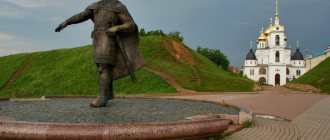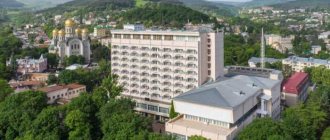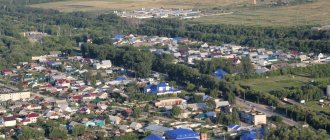The name of the city was determined by the famous forests surrounding it. Debry - Debryansk, and then just Bryansk. These forests performed considerable service during the Second World War. Partisan resistance existed and operated in them. Numerous sights of Bryansk have carried the memory of those incidents to our time. Even the structure of the city itself is remarkable. It’s as if there are no borders for the Bryansk forest. It divides the territory in confident stripes between the Sovetsky, Bezhitsky, Fokinsky, Volodarsky districts, making its way through the topographic center itself. It is accompanied by the Volga River flowing between overgrown ravines.
The Bryansk Automobile Plant is recognized as one of the outstanding symbols of the city. This enterprise is considered a leader in the industry of production of tractors with a carrying capacity of 14-40 tons and wheeled chassis for military and civilian equipment. Among the consumers of BAZ products are the Ministry of Defense of the Russian Federation, crane builders, and oil and gas enterprises.
City of Military Glory
The Great Patriotic War was a difficult period not only for the entire Soviet Union, but also for each of its cities. Like many others, Bryansk was an important strategic site in terms of the seizure of Soviet territories by fascist troops. Residents of the city selflessly fought the enemy, drawing off large enemy forces. For a month and a half, under heavy bombing and artillery shelling, enduring heavy battles for the city, its defenders held off the enemy on the road to Moscow.
In October 1941, Bryansk was captured and destroyed, its lands were occupied until 1943. Many residents were taken prisoner, tortured and abused, and shot. Nineteen partisan detachments functioned in the forests of the Bryansk region. An underground organization operated in the city itself. Their activities held large enemy forces near Bryansk; the Nazis suffered heavy losses from sabotage and raids by partisans and the work of underground fighters. In Bryansk itself there was also a partisan detachment commanded by D. E. Kravtsov. The history of the partisan movement in the Bryansk region is reflected in the history of the “Partisan Glade” in Bryansk.
Mansion of the merchant Abraham
The mansion, built in the 19th century, is an architectural monument. It is located near the Gorne-Nikolskaya Church. The mansion is made in the Gothic style, which is not typical for this region. During the Second World War, the building was slightly destroyed, but subsequently it was reconstructed. Now the mansion is the location of the Diocesan Administration.
Location: Arsenalnaya street - 6.
Bryansk: memorial to the Great Patriotic War
One of the large memorial monuments to the heroes of the Great Patriotic War in Bryansk is the Motherland Monument, installed next to “Peresvet and Bayan” on Pokrovskaya Mountain. The full-length figure of the Motherland is made of bronze and holds in his hands the symbols of the Soviet state - a sickle and a hammer.
The central memorial of the city, dedicated to all the fallen residents and defenders of Bryansk, was the Mound of Immortality, located in the Nightingales park. A twelve-meter-tall mound, which grew from soil brought here from all the hero cities of the Soviet Union and the Bulgarian sister city of Shipka, is crowned with an eighteen-meter-tall image of a five-pointed star. The basis of the mound is a military cannon from the war.
Park Museum named after. A.K. Tolstoy
The park museum is one of the oldest parks in Bryansk. It was opened in 1936. On its territory there is a unique collection of wooden sculptures. In the fifties of the last century, the park's perennial elms began to fade.
In 1960, two young sculptors, on their own initiative, recreated the very first sculpture of a storyteller from the trunk of an endangered tree. After the appearance of this sculpture, more and more sculptors, as well as schoolchildren engaged in wood carving, began to visit the park. And so the creation of fabulous sculptures in the park continued.
However, the first sculptures did not last long, only 12 years, after which they decayed. But other works soon appeared in their place. New sculptures are being created in the park today. Due to its uniqueness, the park is visited annually by a large number of both local residents and tourists from other countries.
Location: Gagarin Boulevard - 33.
Bryansk: memorials to motorists and pilots
A monument is dedicated to the motorist soldiers who fought against fascism in the village of Osinovaya Gorka near Bryansk, the homeland of a special motor vehicle battalion. The monument is a thirty-meter stele, at the foot of which is the figure of a military driver standing in front of his car. A museum has been created nearby, located in a reconstructed military dugout. Opposite across the road are military vehicles that complement the memorial complex.
Another Bryansk monument is dedicated to the exploits of military pilots. This is a plane taking off. The monument was erected in memory of the pilots of the 3rd Fighter Aviation Division, who fought in the skies over Bryansk, and three Guards Aviation Regiments - 32, 64, 65. The creation of the Guerrilla Glade memorial complex is also connected with the pages of the military history of Bryansk.
Memorial to Partisans
In Bryansk, at the end of the sixties of the 20th century, a memorial complex was created, which was given a name associated with the history of the partisan movement in the Bryansk region that existed during the war years - “Partisan Glade”. After all, it was here, on the banks of the Snezhet River, that at the beginning of 1941 a historic gathering of city and district partisan detachments took place, preparing to jointly stop the enemy on the approaches to the city, prevent occupation and delay the advance of Hitler’s army.
The memorial complex, created according to the design of V.N. Gorodkov not far from White Beach, became the site of annual meetings of partisan veterans and underground veterans of Bryansk. Near the half-mast banners frozen on the Wall of Memory, the Eternal Flame, built in the form of a partisan fire, burns on the site. Every year, on memorable dates, flowers and wreaths with the names of heroes are brought to him and to the Wall with the names of heroes by partisan heroes who have survived to this day, and by the descendants of all those who gave their lives for peace on Bryansk land.
Project “Known and unknown monuments of Bryansk” history project
- Project work passport:
- Abstract to the project.
- Objective of the project.
- Target audience, customer.
- Project objectives.
- Stages and methods of working on the project.
- Required equipment and/or cost estimate.
- Feedback from the manager.
- Project support sheet.
- Description of the execution process.
- Conclusions and self-analysis of the work on the project.
- List of sources of information on the project.
Application.
Abstract to the project. In 2022, the Bryansk region celebrated the 75th anniversary of its liberation from the Nazi invaders. The Great Patriotic War remains in our memory, no matter what generation we belong to. Indeed, our life is closely connected with the history of our country. Every day, passing by monuments, the younger generation has no idea of their significance. Despite the rich history of Bryansk, most of the students at our school do not know the monuments dedicated to the Great Patriotic War, as the conversation showed. We decided to create a project in which we highlighted some historical moments of our city of Bryansk. With the help of this project, we hope that the students of our school will become acquainted with new facts from the history of memorable places in the city of Bryansk. Therefore, we must study more deeply, get acquainted with the historical monuments of Bryansk, create an information poster that can be used when conducting classroom hours and extracurricular activities “Bryansk Region”. Purpose of the work: to expand knowledge about the heroic past of Bryansk.
The target audience and customer of our work were students in grades 1-4 and primary school teachers.
Project objectives:
- Create and conduct a survey among 2nd grade students.
- Study literature, Internet sites, visit the library, museum.
- Systematize the information received and create an information poster.
- Deepen students' knowledge of the history of Bryansk. 5. Introduce students to the results of their work.
Stages and methods of working on the project.
Theoretical methods were used in the work: search, work with literature and other sources of information, analysis of material, generalization.
Work on the project took place in three stages. At the first stage in September - October, the topic of work was determined, working groups were created, the problem of work was determined, and the tasks of the work were determined. At the second stage, in October–November, the collection and processing of material was carried out, and a layout of the guidebook was created. At the third stage, there was a wall newspaper in December, and a presentation was developed in January 2022. The work was presented to 2nd grade students, who became acquainted with the monuments and their history. Project participants worked with literature and Internet sites on the project topic. All materials were systematized and summarized, a layout was made, and a presentation was made.
Interim results of the project were summed up and discussed throughout the work on the project. At the end of each stage, an analysis of the results obtained was carried out. Project participants were informed about the progress of work on the project. Necessary equipment and estimate.
Equipment:
- Computer, Internet.
- Encyclopedias, literature.
- Illustrations on the theme of the project. 4. Poster printing in a printing house (640 rubles). Feedback from the manager. Students of grade 2b Mokiya Ruslan, Shemet Polina, Buldina Arina worked on this educational project. The work has practical significance, expanding knowledge of the history of the native land, the ability to work with literature, and Internet resources. This work substantiates the relevance of the chosen topic for modern society. The monuments in our city are not accidental; they have their own history and author. Monuments are works of art created to perpetuate the memory of certain events and people; they are a cultural part of our city and people. This work defines the goal, objectives, and discusses its significance. A variety of work methods were used: analysis of material, generalization, work with various sources of information. In the process of work, the activities of each project participant were clearly defined, the final result, the product of the work was determined. The work meets the requirements for writing an educational project. In the process of completing the work, students showed such qualities as responsibility, discipline, and diligence. Project support sheet.
This work is an integrative didactic means of development, training and education, which allows you to develop and develop specific skills in design and research, namely to teach:
- problematization, consideration of the problem field and identification of subproblems, formulation of the leading problem and formulation of tasks arising from this problem;
- goal setting and planning of meaningful student activities;
- self-analysis and reflection, effectiveness and success in solving the project problem;
- presentation of the results of its activities and progress of work;
- presentations in various forms, using a specially prepared design product, a created dictionary;
- searching and selecting relevant information and mastering the necessary knowledge;
- practical application of school knowledge in various, including atypical, situations;
- selection, development and use of suitable technology for manufacturing a design product;
- conducting research, analysis, synthesis, proposing a problem, detailing and generalizing.
When working on a project, great attention is required to the process of comprehension, purposeful acquisition and application by students of the knowledge necessary in one form or another. It is necessary to direct the search for the necessary information, to help students find the necessary sources of this information. Interim results of the project were summed up and discussed throughout the work on the project. At the end of each stage, an analysis of the results obtained was carried out. Project participants are informed about the progress of work on the project.
Expected results:
— increasing the level of students’ knowledge of history;
- group work skills;
— development of personal, cognitive, regulatory and communicative abilities of students;
— ensuring students’ employment during extracurricular hours, satisfying their needs for activities of interest and self-expression.
Description of the project. 2nd grade students worked on the project, expanding and deepening their knowledge of the history of Bryansk. Materials from encyclopedias, literature, Internet sites were studied, and the museum named after. D.N. Medvedev (D.N. Medvedev House of Culture). Participants in the project were primary school teacher Larina Svetlana Aleksandrovna, 2nd grade students Mokiya Ruslan, Shemet Polina, Buldina Arina, parents of 2nd grade students, library workers, museum workers, and the school scientific society. Preparatory stage. As a result of brainstorming, the project “Such famous and unknown monuments of Bryansk” was chosen. The problem, goals and objectives of the work were defined. Options for solving the set goals and objectives have been worked out. Main stage. Responsibilities were distributed among the project participants, and the group commander, Mokiya Ruslan, was selected. With the help of primary school teacher Larina S.A. we have compiled a list of questions for 2nd grade students (see Appendix 1). After analyzing the students’ answers, we learned what is known about which monuments. Together with primary school teacher Larina S.A. we visited the museum. D.N.Medvedev, where the guide spoke about D.N.Medvedev. We learned that a monument made of granite and bronze to the commander of the partisan detachment, Hero of the Soviet Union Dmitry Nikolaevich Medvedev was opened in the city of Rovno in 1989 by Y.P. Kolesnikov and L.Yu. Zakrevsky, and in 1993 it was brought to Bryansk. A monument was erected near the hero’s house in the Bezhitsa district at the intersection of Medvedev and 3rd International streets. Dmitry Nikolaevich was born on August 10, 1898. in the city of Bezhitsa (now Bezhitsky district of Bryansk). At the beginning of the 20th century, he studied at a men's gymnasium. Later he took part in the revolution, fought against banditry and spies. In the 1930s he was expelled from the party, but with his hunger strike he achieved reinstatement into the party. In 1941, from the first days of the war, Medvedev organized the Mitya partisan detachment in the Bryansk forests, which carried out a huge number of battles, liquidations, and explosions. He formed the “Winners” detachment to work in the rear. From 1942 to 1944 he fought 120 major battles. The “Winner” detachment created 10 new partisan detachments. For all his services, Dmitry Nikolaevich Medvedev was awarded the title of Hero of the Soviet Union with the Order of Lenin and the Gold Star medal. After the war, the commander became a writer. His books have been published in many languages of the world and have been filmed several times. Medvedev died on December 14, 1954 in Moscow. A street and the Palace of Culture in Bezhitsa are named after him in Bryansk. Shemet Polina visited the library, where the librarian helped her find information about monuments in literature. Polina learned that the bust of Pavel Mikhailovich Kamozin was installed in the Bezhitsky district of Bryansk on Komsomolskaya Street in the park named after A.S. Pushkin. The pilot was born here on July 16, 1917. He worked as a mechanic at Bryansk (now BMZ). He came there after graduating from college in 1934. Then he decided to enter the regional flying club and post-flight school. And finally, in October 1942, the active army. During the Great Patriotic War, the fearless air fighter made 750 combat missions, personally shot down 35 and 13 enemy aircraft in group battles. In May 1943, Kamozin was awarded the title of Hero of the Soviet Union, and in June 1944 he was awarded the second Gold Star medal. After the end of the war, Pavel Mikhailovich worked in Bryansk in civil aviation. Died November 24, 1983. Mokiya Ruslan and Buldina Arina turned to their parents for help, who helped them find relevant information on the Internet. They learned that the Immortality Mound is a monument to those who fell in the fight against the Nazi invaders, which became one of the symbols of the city of Bryansk. Located in the Sovetsky district of the city, in the Central Park of Culture and Leisure “Nightingales” (named after the 1000th anniversary of Bryansk). It is an artificial earthen embankment in the form of a pentagonal hill with a total volume of over 20 thousand cubic meters and a height of 12 meters, which is crowned by an 18-meter concrete pylon in the form of a five-pointed star. The Mound of Immortality was founded on May 7, 1967. Soil from mass graves from the cities and villages of the Bryansk region, from the hero cities of the USSR, and from the Bulgarian Shipka was delivered to the place where it was laid. The solemn ceremony of laying the Kurgan was attended by mothers of soldiers who died during the Great Patriotic War, veterans of war, revolution and Komsomol, Heroes of the Soviet Union, holders of the Order of Glory, leaders and participants of the partisan movement and underground, soldiers of the Soviet Army and the youth of the city. The construction of the Kurgan was timed to coincide with the 50th anniversary of the October Revolution. Buried at the base of the Kurgan is a gun barrel with a capsule containing an appeal to the Bryansk descendants of 2022 (the year of the 100th anniversary of the October Revolution). Stele “City of Military Glory” On June 28, 2010, a stele was solemnly opened in Bryansk in honor of conferring the title “City of Military Glory” on Bryansk. The Square of Military Glory is located on the Mound of Immortality. The stela “City of Military Glory” is the same for all awarded cities. It is a granite column made in the Doric order, topped with a double-headed eagle made of gilded bronze. The height of the column is 10,350 meters. The text of the Presidential Decree on conferring the title “City of Military Glory” is located on the pedestal of the column on the side of the main facade in a bronze cartouche. On the reverse side is the bronze coat of arms of the city. This entire structure is located on a granite platform measuring 17 by 17 meters. In the corners there are four pedestals with bas-reliefs describing memorable heroic events and feats of arms in the history of the city: this is the participation of Bryansk residents in the Battle of Kulikovo, in the Battle of Borodino, in World War I and the Great Patriotic War. In addition, the feat of our fellow partisans and such significant events as the creation of the Bryansk Arsenal and the Bryansk Flotilla are reflected here. Then Svetlana Aleksandrovna helped us highlight the main thing, correct shortcomings, and print an information poster - “Such famous unknown monuments.” The final stage. Together with my parents, we drew up the project. Svetlana Aleksandrovna helped us prepare a presentation of the project. Conclusions and self-analysis of the work on the project Having completed this work, we learned what monuments there are in Bryansk, their history of creation, and significance for subsequent generations. At the end of the work, we introduced our classmates to monuments that were unknown to them and their history, to establish a connection between the past, present and future. We have produced an informational poster and presentation that can be used by students in grades 1-4 and teachers in lessons about the environment and in extracurricular activities. Based on the results of the work, we made the following conclusions: 1) a monument is an architectural or sculptural structure in memory of or in honor of a person or event; 2) it is important to know the history of the creation of monuments; 3) it is necessary to study monuments as part of the history and culture of our people.
References: 1.T.K. Gladkov “Legends of Soviet intelligence”, M., “Veche”, 2001.
2. Y. Sokolov “Milestones of Memory”, Bryansk, 2006. 3. Internet resource. https://kray32.ru 4. Internet resource. https://puteshestvie32.ru
Composition of the complex
The operating hours of the “Partisan Glade” are available to any visitor. The complex is open to the public every day, seven days a week, but the museum's opening hours are limited depending on the season. In winter and autumn - from 9.00 to 16.30. In summer and spring - 9.00 - 17.30. The museum exhibition organizes excursions for both adults and children. And from the city, tour operators conduct bus excursions with visits to the memorial: their route includes a visit to the partisan dugouts, a museum and a diorama, as well as a sightseeing tour around the territory - from monument to monument. Pre-booked excursions are in demand. They can be ordered by phone and on the complex’s website.
The central objects of "Polyana" are the Eternal Flame, a twenty-meter obelisk and the Wall of Memory, on which the names of eight thousand partisans and underground fighters who gave their lives for the salvation of Bryansk and in the fight against fascism are immortalized, a museum of the history of the partisan movement and a museum of their life, a stele with a map of the partisan movements in the Bryansk region, an exhibition of military equipment, the Alley of Heroes and the Alley of Memory. Also on “Polyana” there are steles in memory of the partisan brigades named after the hero of the Civil War, Nikolai Aleksandrovich Shchors, and the leader of the partisan detachment of the city of Bryansk, Dmitry Efimovich Kravtsov, who in those years were considered ideal images of military patriots of the Motherland.
Mound of Immortality
This is one of the most important historical places in the city; the obelisk was opened in 1967. It amazes with its size and monumentality and is one of the symbols of Bryansk. When work was carried out to create this monument, thousands of city residents took part in it. The height of the mound is about 12 meters. Mothers of fallen soldiers from surrounding villages and towns brought soil here from mass graves where their sons were buried. Huge pointed stars rise on the hill as an eternal reminder of those soldiers who did not return from the battlefields.
"Corner of partisan life"
There are unusual objects in the “Partisan Glade” memorial: reconstructions of military dugouts and dugouts, in one of the dugouts there is a “Corner of Partisan Life”. In a small log room in the ground you can see the bunks on which the partisans slept. In summer they are covered with mown grass, and in winter with hay. There is a roughly hewn wooden table and similar benches. The room is heated by a potbelly stove made from an old metal barrel, and illuminated by a lantern that used to be called a “bat” - essentially a portable kerosene lamp. The roof slopes of the dugout are supported by log pillars; there is no ceiling. There are portraits on the end wall.
Two alleys
In the eighties, residents of the city, veterans of the partisan movement, laid out a Memory Alley here. She was dropped off in 1981 at a memorable meeting by veterans of the partisan and underground movement in Bryansk. And in 2014 - another alley, perpetuating the memory of the partisan heroes of the Bryansk forests.
This corner of memory occupies an important place in the ensemble of the memorial complex. Along the black granite wall, 14 participants in the partisan movement in the Bryansk region froze in bronze. Among them are twelve Heroes of the Soviet Union and two Heroes of Russia. In the center of the composition, created by sculptor A. Romashevsky, granite stars are placed.
Among the heroes, the memory of whose feat will be preserved for centuries on the Alley of Heroes, is the commander of the partisan brigade named after. Shchorsa Mikhail Romashin, who led it during the operation to blow up the Blue Bridge.
I would also especially like to highlight Valentina Safronova, who is known to the residents of Bryansk as “the daughter of the Bryansk forests.” Being wounded, she was captured by the Nazis, but during torture and interrogation she remained steadfast, as befits a partisan. She died in fascist dungeons. Like V. Safronova, Nikolai Kuznetsov took part in intelligence operations.
Among the heroes is a native of Kalmykia, Mikhail Selgikov. Like Alexey Izhukin, Mikhail took part in sabotage operations related to the bombing of important strategic objects, as well as in the “hunt” for languages.
Bryansk Regional Theater for Young Spectators
The theater was founded on February 18, 1981. During his work, he presented his audience with more than 130 performances. The theater troupe is very talented, and it includes both experienced artists and fairly young ones who learn from the experience of their older colleagues. The theater staff often goes on tour. The artists tour both throughout the Bryansk region and stage performances in various cities of Russia, as well as in Ukraine and Belarus.
Location: Gorky street - 20.
Museum of the Partisan Movement
At the end of the seventies, a museum of the history of the partisan movement in the Bryansk lands appeared as part of the complex. Despite its small size, glass display cases as high as the walls contain a large number of exhibits of the military history of the Bryansk region. Here you can see authentic photographs and documents from the time of the Great Patriotic War, personal belongings of partisans, weapons and birch bark newspapers that were published by partisans and underground fighters, household items of partisans, and even a fragment of a forge that the partisans used to repair weapons. Its exhibition also includes the diorama “The Explosion of the Blue Bridge.”
"Blue Bridge Explosion"
The diorama in the Museum of the History of the Partisan Movement of Bryansk on the territory of the “Partisanskaya Polyana” memorial complex captured an important moment in the history of the military epic of 1941-1945. This bridge spans the Desna River and is located on a branch of the railway running from Bryansk to Gomel. The bridge is made of gray metal, which looks blue in special lighting. Hence the name.
During the years of the fascist invasion, the Blue Bridge was the most important strategic object for both the Russian and Hitler’s armies. During the occupation of the Bryansk region, the Germans transported trains with military equipment, ammunition and manpower across the bridge. Understanding all the consequences of the loss of this important military facility, the Nazis took care of its protection by erecting an entire system of ditches, pillboxes, bunkers, and minefields. But despite all the measures taken, the partisan brigade named after. Shchorsa, partisan detachment named after. Bauman and partisans of the regional Bryansk detachment and detachments of adjacent areas carried out an operation, as a result of which the Blue Bridge was blown up. This important event took place in 1943.
Exhibition of military equipment
In 2007, an exhibition of military equipment from the Great Patriotic War was held on the territory of Partizanskaya Polyana. Here you can see tanks and armored personnel carriers from the war era, and helicopters. There are also firearms here, for example the Shavyrin mortar, cannons made in the Grabin design bureau and in the Petrov design bureau, howitzers of various models of pre-war production, a tracked tractor and tracked self-propelled mortar units, multiple launch rocket systems, reconnaissance and patrol vehicles. Later, the exhibition was replenished with specimens of modern weapons: rocket launchers and missile shells, high-explosive aerial bombs, etc.
In 2014, construction of the chapel “In the name of all the Saints who shone in the Russian land” began on the territory of the “Partisanskaya Polyana” memorial complex.
How to get to Partizanskaya Polyana? To do this, you just need to take a bus from the city bus station to the memorial complex. Moreover, there are several routes to Partizanskaya Polyana, and buses travel along them regularly. The address of “Partizanskaya Polyana” in Bryansk is Privokzalnaya Street, near building 4.
"Hatsun"
This is a memorial complex dedicated to the victims of the fascist invaders. Khatsun is a small village in the Bryansk region, all of whose residents, as well as people hiding on its territory, were shot by German troops in 1941. And in 1942 the village was completely burned down.
The idea of creating a memorial arose in 1977, but then the construction of the complex was not completed. Only in 2009 did the reconstruction of the memorial begin and in 2011 the updated “Hatsun” was opened. The memorial complex consists of several objects, some of which are a museum, a chapel, an obelisk of military glory, and a mass grave.











